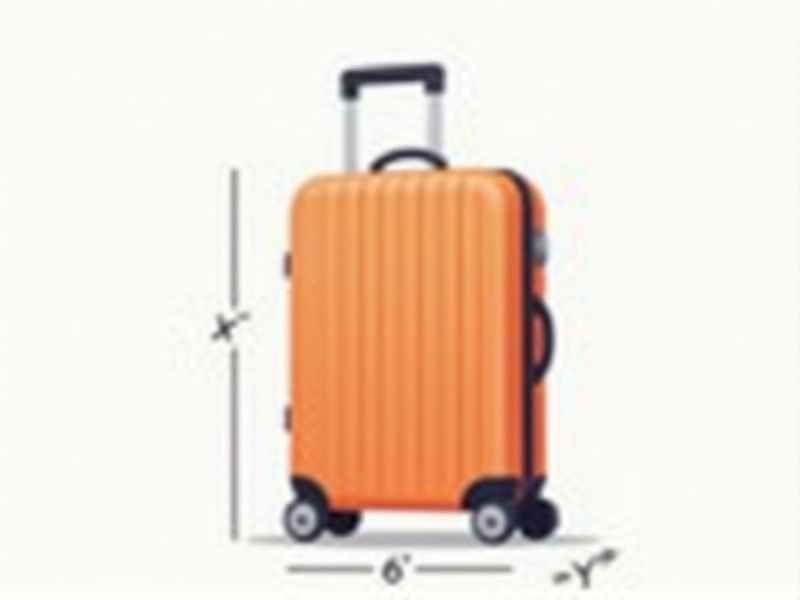
When choosing a suitcase, understanding standard dimensions can help ensure your luggage meets airline requirements and fits your travel needs. Most airlines consider carry-on suitcases to be up to 22 x 14 x 9 inches (56 x 36 x 23 cm), including wheels and handles. Checked luggage commonly allows for dimensions up to 62 linear inches (length + width + height combined), though this can vary by airline. Always double-check your airline's specific guidelines before your trip to avoid additional fees or complications at the airport.
Airline Carry-On Size Restrictions
Airlines typically permit carry-on luggage dimensions of up to 22 inches in height, 14 inches in width, and 9 inches in depth, including wheels and handles. Many carriers enforce strict weight limits, often capping it at 15-25 pounds, which varies by airline. Choosing a suitcase designed to maximize space while adhering to these size constraints can enhance your travel experience. Ensure your carry-on meets the specific requirements of the airline you are flying with to avoid unexpected fees or the inconvenience of checking your bag.
Maximum Weight Limit
A standard suitcase typically accommodates a maximum weight limit ranging from 50 to 70 pounds, depending on airline regulations. Choosing a suitcase with a lightweight design can help you maximize packing capacity without exceeding these limits. Many models also feature durable materials to withstand wear and tear during travel, ensuring your belongings remain secure. When selecting your suitcase, consider both the weight and the size to efficiently utilize available space while adhering to travel restrictions.
Checked Luggage Size Guidelines
Checked luggage must comply with airline regulations, typically measuring a maximum of 62 linear inches (length + width + height) and weighing no more than 50 pounds (22.7 kg) for economy class. Airlines may impose additional fees for overweight or oversize bags, which can range from $50 to $300 depending on the carrier. Ensure your suitcase features sturdy wheels and handles for ease of maneuverability at airports, where over 1.4 billion passengers traveled in 2019. Familiarize yourself with your airline's specific checked luggage policies, as these can vary significantly and impact your travel experience.
Expandable Suitcase Options
Expandable suitcases offer the flexibility of additional packing space, typically increasing by up to 25%. Designed with a zippered expansion feature, these suitcases cater to travelers who may need extra room for souvenirs or additional clothing. Many models include durable, lightweight materials like polycarbonate or ballistic nylon, ensuring both protection and ease of transport. When selecting an expandable suitcase, consider features such as spinner wheels for 360-degree maneuverability and integrated TSA locks for enhanced security.
Spinner Vs. Roller Wheels
Spinner wheels, which are typically found on modern suitcases, offer 360-degree mobility, allowing you to easily maneuver through tight spaces and crowded areas. In contrast, roller wheels, designed for straight-line movement, provide stable support, especially on uneven surfaces, but require more effort to change direction. Many travelers prefer spinner suitcases for their convenience, particularly in airports, while roller wheels are favored for their durability and longevity. For your next suitcase choice, consider the scenery you'll navigate to find the best wheel option suited for your travel needs.
Hardside Vs. Softside Material
Hardside suitcases often utilize materials like polycarbonate or ABS, providing exceptional protection for fragile items and resisting impact. In contrast, softside suitcases typically feature nylon or polyester, offering flexibility and expandability for added packing space. Hardside options usually weigh between 6 to 10 pounds, while softside variants generally range from 4 to 8 pounds, making the latter lighter and easier to maneuver. When considering durability, hardside models excel in resisting wear, whereas softside bags may be more susceptible to tears but often come with exterior pockets for convenient access.
Tsa-Approved Locks
A suitcase equipped with TSA-approved locks ensures your belongings remain secure while allowing Transportation Security Administration agents to inspect your luggage without damaging the lock. These locks typically feature a universal key system, enabling authorized personnel to access your bag in case they need to conduct a security check. When purchasing a suitcase, look for models that explicitly mention TSA approval, as this enhances convenience during travel. Choosing a suitcase with such locks can provide peace of mind during your journey, knowing your items are both safe and accessible for inspections.
Built-In Compression Systems
Built-in compression systems in suitcases enhance packing efficiency by minimizing the overall bulk and optimizing space. These innovative designs can reduce suitcase volume by up to 30%, allowing you to fit more items without exceeding airline weight limits. Many models feature adjustable straps that secure packed belongings and prevent shifting during travel, ensuring your items remain organized. When choosing a suitcase, look for those equipped with this technology to maximize your packing potential and minimize hassle.
Waterproof Or Water-Resistant Features
When selecting a suitcase, consider waterproof or water-resistant features, which can greatly enhance durability and protect your belongings. Waterproof materials, such as thermoplastic polyurethane, provide full protection against heavy rain and splashes, whereas water-resistant options may withstand light moisture but are not entirely impervious. Look for suitcases with sealed zippers and reinforced seams to ensure that water does not infiltrate the interior. Choosing a suitcase with these features can ultimately safeguard your items, especially during unpredictable travel conditions.
Interior Organization Compartments
Suitcases designed with superior interior organization compartments often include multiple pockets, dividers, and straps to maximize space and secure belongings during travel. Typically, a well-structured suitcase may feature up to six separate compartments, allowing for optimal categorization of clothing, shoes, and accessories. For travelers, having these organizational tools can reduce packing time and enhance accessibility, making it easier to retrieve items without rummaging through the entire bag. Investing in a suitcase with prioritized interior organization can significantly improve your overall travel experience by promoting efficiency and order.
